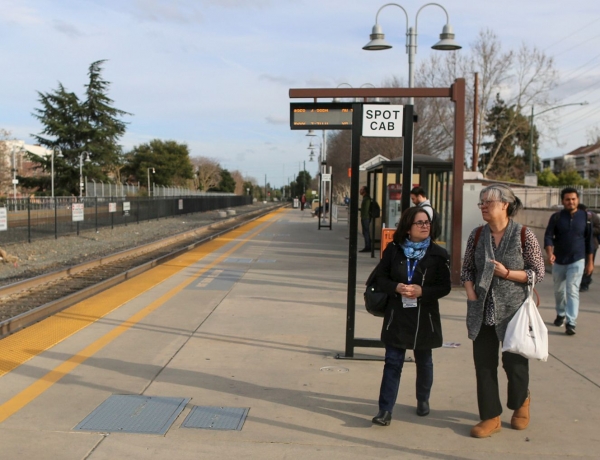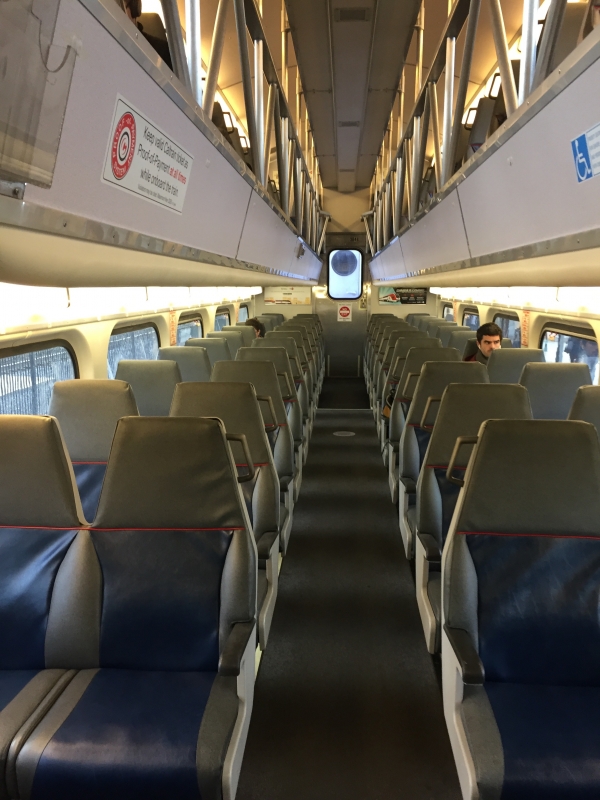Despite plummeting ridership and growing anxieties about the coronavirus, transportation agencies are planning to keep trains and buses running on their regular schedules — at least for now.
As the number of coronavirus cases has climbed in Santa Clara County over the past week, transit agencies have upped their outreach efforts with tip sheets and brochures advising riders to cover their coughs, avoid touching their faces and to stay home if they're feeling sick.
Many riders appear to have gotten the message. On Caltrain, ridership appears to have dropped off over the past week, with morning trains that are typically standing-room-only now featuring a wealth of empty seats. With many tech employees now working from home, a Tuesday morning train was three-quarters empty as it approached the Palo Alto station. One conductor compared the ridership levels to those during the Great Recession in 2008-2009.
Caltrain generally tracks ridership on a monthly basis, with numbers for March typically not available until late April, agency spokesman Alex Eisenhart said. Given the circumstances, Caltrain is planning to release some preliminary numbers next week. That said, train conductors are reporting seeing fewer riders during peak commuting hours. This, he said, could either mean that fewer people are riding or that more people are shifting to off-peak trains, in accordance with recommendations from public health leaders to avoid crowded spaces.
"It's very likely many people are staying at home and working from home," Eisenhart said.
But while transit agencies are providing advice, they are not preparing to modify their schedules just yet. Neither Caltrain nor the Santa Clara Valley Transportation Authority have made any decision to change service levels as of Tuesday evening, though Eisenhart said that Caltrain may have to reconsider the extra service it provides to large events at San Jose's SAP Center and Chase Center and Oracle Park in San Francisco.
He noted Santa Clara County's order on Monday to cancel large gatherings in the county. If events get canceled, so would the Caltrain services associated with those events, he said.
Like other transportation agencies, Caltrain has been taking its cues from county health officials and the Centers for Disease Control and Prevention. The San Mateo County Transit District, which administers the SamTrans bus service and Caltrain, is maintaining regular contact with local public health agencies, the Metropolitan Transportation Commission and the CDC, the district's CEO Jim Hartnett said in a video explaining the agency's response.
On its website, Caltrain pointed to the CDC's determination that immediate risk posed by COVID-19 to the public remains relatively low. The agency encouraged riders to wash their hands with soap before and after riding public transit; to avoid eating while onboard; to cover coughs and sneezes with their elbows; and to avoid touching their eyes, nose and mouth.
"While our buses and trains are cleaned and sanitized regularly, taking these simple precautions is in the best way to minimize your risk of exposure," Hartnett said in the video. "We will continue to monitor the situation as it unfolds and respond as necessary, in partnership with local public health and transportation agencies."
The Palo Alto Shuttle also plans to maintain its regular schedule, said Chief Transportation Officer Philip Kamhi. The city has a dedicated webpage offering information about preventive measures residents should take to reduce risk of respiratory illnesses, which can be found here. The city has also put together a flyer that includes a "Frequently Asked Questions" section and is being printed and distributed to passengers on shuttles, he said.
Stanford University was also still running its Marguerite Shuttles on Tuesday, even as the university has announced that it is shifting classes from in-person to a "virtual format" and asked its undergraduates to leave campus at the end of the quarter. Stanford's transportation division is engaged with Stanford Environmental Health & Safety to monitor the situation and "respond as necessary in an effort to help limit the spread of infection," according to the university's website.
The VTA is retaining its regular schedule and ramping up its educational offerings in response to COVID-19. The agency's weekday ridership has decreased by 5% since mid-February, according to VTA Public Information Officer Ken Blackstone.
The VTA underscored on its website that surface transmission is "not a significant focus at this time." The agency's dedicated page notes that the CDC has recommended frequent, routine cleaning of surfaces — advice that the VTA said "aligns with (its) protocols."
VTA buses and light-rail vehicles are cleaned daily, the agency announced. In addition, service workers wipe down the interior and frequently touched surfaces are disinfected using a bleach-based cleaning solution, its page states.
"Our goal is to keep our employees and riders informed on how best to stay healthy and prevent exposure to viruses," the VTA page states. "VTA employees are receiving ongoing updates and tools (like gloves and travel hand sanitizer) to reduce exposure. Additionally, hand sanitizer dispensers have been placed at all work divisions."
Mountain View Voice Editor Andrea Gemmet contributed to this report.
Read our latest updates on local coronavirus cases here.
Find comprehensive coverage on the Midpeninsula's response to the new coronavirus by the Almanac, Mountain View Voice and Palo Alto Online here.




Comments
Another Palo Alto neighborhood
on Mar 10, 2020 at 5:47 pm
on Mar 10, 2020 at 5:47 pm
Pretty poor show if Caltrain can't work out whether there is lower overall ridership or that people are using off peak trains to ride.
Why are we in the stone age when it comes to technology in Silicon Valley? If every rider has to click their clipper card, there has to be time by hour counting ability.
South of Midtown
on Mar 10, 2020 at 6:54 pm
on Mar 10, 2020 at 6:54 pm
[Portion removed.] My commute times to work have never been better, people seem less rushed and more polite. I wish it could stay this way forever
Menlo Park
on Mar 10, 2020 at 8:48 pm
on Mar 10, 2020 at 8:48 pm
Definitely enjoyed the Corona Light traffic the past two days. Hoping this work from home thing sticks permanently.
Old Palo Alto
on Mar 10, 2020 at 9:15 pm
on Mar 10, 2020 at 9:15 pm
Not just public transit. Traffic on Hwy 101 is much lighter these days. Hard to tell if this is because of telecommuting or unemployment.
Downtown North
on Mar 11, 2020 at 8:55 am
on Mar 11, 2020 at 8:55 am
Keeping same schedule has the public benefit of allowing people to maintain greater distance between one another.
As for counts, Caltrain's new EMUs have automatic door counters, so numbers will be available sooner in the future.
Midtown
on Mar 11, 2020 at 12:11 pm
on Mar 11, 2020 at 12:11 pm
@Resident Monthly pass holders and GO pass holders don't have to tag on and off, so it's hard for Caltrain to track how much they're actually riding.
College Terrace
on Mar 11, 2020 at 2:58 pm
on Mar 11, 2020 at 2:58 pm
[Post removed.]
College Terrace
on Mar 11, 2020 at 9:29 pm
on Mar 11, 2020 at 9:29 pm
There is a major health and safety risk at the bus shelter at West College and ECR. The shelter is covered in urine and trash. Very unsanitary. VTA please take care of it.
Another Palo Alto neighborhood
on Mar 11, 2020 at 10:05 pm
on Mar 11, 2020 at 10:05 pm
Resident said: Why are we in the stone age when it comes to technology in Silicon Valley?
Passenger-rail is a one-dimensional dead-end technology that was conceived to serve the pastoral landscape of 19th century England. The passenger-rail industry has not been profitable for 85 years, has no profits to invest in R&D, and is managed by government bureaucrats placed in their positions to serve the wealthy real-estate developers that fund the Party, not the public.
The Wuhan flu pandemic highlights what we have all known but have quietly ignored for years. Passenger-rail is a very efficient vector for transmission of a naturally occurring communicable disease or a bio-warfare agent introduced by a hostile power or terrorist organization.
As far back as 1966 the US Army conducted tests of biological agents in the New York subway system. The "tests were conducted not only to assess the vulnerability of subway systems to covert biological attack, but also to determine methods of delivery that could be used offensively." Web Link
Another Palo Alto neighborhood
on Mar 12, 2020 at 10:00 pm
on Mar 12, 2020 at 10:00 pm
Rush hour Caltrain very sparsely populated.
Driving north on Alma/Central today around 5:30pm I noticed very few head shaped silhouettes in the windows of a passing northbound train. Good to see citizens taking responsibility for social distancing into their own hands instead of waiting for Caltrain "management" to do the right thing.